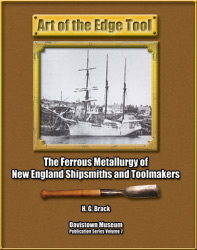
 Art of the Edge Tool
Art of the Edge Tool
H.G. Brack
2nd edition, 2008
“A thoroughly informed review of the history of edge tools, … the devices used by New England craftsmen to build a maritime economy and ultimately a nation. …spans 280 years of shipbuilding history, charting both the evolution of steelmaking between 1607 and 1882 and the growth of the economy that relied on it in times of revolution, war, and peace.” Kirkus Discoveries Narrates the history of edge toolmaking and shipsmithing in New England and its links to the bog iron country of Southeastern Massachusetts in the context of a flourishing Colonial maritime economy.
Softcover, 8" x 10"
$15.00
Available on Amazon.com
Hand Tools in History Publication Series Summary
Art of the Edge Tool: The Ferrous Metallurgy of New England Shipsmiths and Toolmakers explores the evolution of tool- and steelmaking techniques by New England’s shipsmiths and edge toolmakers from 1607-1882. This volume uses the construction of Maine’s first ship, the pinnace Virginia, at Fort St. George on the Kennebec River in Maine (1607-1608), as the iconic beginning of a critically important component of colonial and early American history. While there were hundreds of small shallops and pinnaces built in North and South America by French, English, Spanish, and ot her explorers before 1607, the construction of the Virginia symbolizes the very beginning of Ne w England’s three centuries of wooden shipbuilding. This volume explores the links between the construction of the Virginia and the later flowering of the colonial iron industry; the relationship of 17th, 18th, and 19th century edge toolmaking techniques to the steelmaking strategies of the Renaissance; and the roots of America’s indigenous iron industry in the bog iron deposits of southeastern Massachusetts and the many forges and furnaces that were built there in the early colonial period. It explores and explains this milieu, which forms the context for the productivity of New England’s many shipsmiths and edge toolmakers, including the final flowering of shipbuilding in Maine in the 19th century. Also included is a bibliography of sources cited in the text.
Amazon.com description
In this volume of the Hand Tools in History series, author H. G. Skip Brack explores the stories told by the forge welded edge tools discovered in New England tool chests and workshops during his 40 years of searching out useful woodworking tools for the Liberty Tool Company in Maine. Also the founder and curator of the Davistown Museum, Brack wrote The Art of the Edge Tool to complement the museum collection, tell the story of early American toolmakers and answer the questions of when, how and where New England shipsmiths "ironed" wooden sailing ships and forged edge tools for the shipwrights. He explains the milieu of these toolmakers and links it to New England's maritime trading economy and the late 19th century florescence of American hand tool manufacturing and shipbuilding which followed. History buffs and anyone interested in woodworking tools, their history and the role they played in the evolution of America's maritime and industrial economy are sure to enjoy Brack's work.